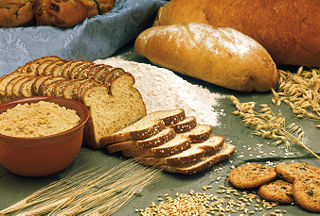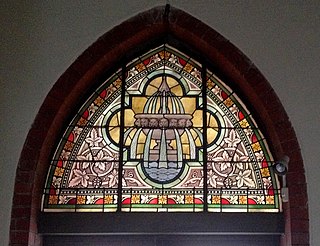
A siddur is a Jewish prayer book containing a set order of daily prayers. The word siddur comes from the Hebrew root ס־ד־ר, meaning 'order.'

The Shulchan Aruch, sometimes dubbed in English as the Code of Jewish Law, is the most widely consulted of the various legal codes in Judaism. It was authored in Safed, Ottoman Syria by Joseph Karo in 1563 and published in Venice two years later. Together with its commentaries, it is the most widely accepted compilation of halakha or Jewish law ever written.

Kiddush, lit. 'sanctification', is a blessing recited over wine or grape juice to sanctify the Shabbat and Jewish holidays. Additionally, the word refers to a small repast held on Shabbat or festival mornings after the prayer services and before the meal.

In Judaism, Rosh Chodesh or Rosh Hodesh is a minor holiday observed at the beginning of every month in the Hebrew calendar, marked by the birth of a new moon. Rosh Chodesh is observed for either one or two days, depending on whether the previous month contained 29 or 30 days.
Moses Isserles, also known by the acronym Rema, was an eminent Polish Ashkenazi rabbi, talmudist, and posek. He is considered the "Maimonides of Polish Jewry."

In Judaism, shechita is ritual slaughtering of certain mammals and birds for food according to kashrut. One who practices this, a kosher butcher is called a shochet.

Orach Chayim, is a section of Rabbi Jacob ben Asher's compilation of Halakha, Arba'ah Turim. This section addresses aspects of Jewish law pertinent to the Hebrew calendar. Rabbi Yosef Karo modeled the framework of the Shulkhan Arukh, his own compilation of practical Jewish law, after the Arba'ah Turim. Many later commentators used this framework, as well. Thus, Orach Chayim in common usage may refer to another area of halakha, separate from Rabbi Jacob ben Asher's compilation.
Lekha Dodi is a Hebrew-language Jewish liturgical song recited Friday at dusk, usually at sundown, in synagogue to welcome the Sabbath prior to the evening services. It is part of Kabbalat Shabbat.

Birkat Hamazon, known in English as the Grace After Meals, is a set of Hebrew blessings that Jewish law prescribes following a meal that includes at least a kezayit (olive-sized) piece of bread. It is understood as a mitzvah based on Deuteronomy 8:10.

Melamed, Melammed in Biblical times denoted a religious teacher or instructor in general, but which in the Talmudic period was applied especially to a teacher of children, and was almost invariably followed by the word tinokot. The Aramaic equivalent was Jewish Babylonian Aramaic: מקרי דרדקי, romanized: maqrē dardaqē.

Kiddush levana, also known as Birkat halevana, is a Jewish ritual and prayer service, generally observed on the first or second Saturday night of each Hebrew month. The service includes a blessing to God for the appearance of the new moon, readings from Scripture and the Talmud, and other liturgy depending on custom. In most communities, ritual elements include the shalom aleikhem greeting and jumping toward the moon, with some communities also incorporating kabbalistic practices.

Mizrah is the "east" and the direction that Jews in the Diaspora west of Israel face during prayer. Practically speaking, Jews face the city of Jerusalem when praying, and those north, east, or south of Jerusalem face south, west, and north respectively.

Psalm 98 is the 98th psalm of the Book of Psalms, beginning in English in the King James Version: "O sing unto the Lord a new song; for he hath done marvellous things". The Book of Psalms starts the third section of the Hebrew Bible, and, as such, is a book of the Christian Old Testament. In the slightly different numbering system in the Greek Septuagint version of the Bible, and in the Latin Vulgate, this psalm is Psalm 97. In Latin, it is known as "Cantate Domino". The psalm is a hymn psalm, one of the Royal Psalms, praising God as the King of His people. Like Psalms 33 and 96, it calls for the singing of "a new song".
Pesukei dezimra, or zemirot as they are called in the Spanish and Portuguese tradition, are a group of prayers that may be recited during Shacharit. They consist of various blessings, psalms, and sequences of other Biblical verses. Historically, reciting pesukei dezimra in morning prayer was a practice of only the especially pious. Over the course of Jewish history, their recitation has become widespread custom among all of the various rites of Jewish prayer.

Psalm 19 is the 19th psalm in the Book of Psalms, beginning in English in the King James Version: "The heavens declare the almighty of God; and the firmament sheweth his handywork." In the slightly different numbering system used in the Greek Septuagint and Latin Vulgate translations of the Bible, this psalm is Psalm 18. The Latin version begins "Caeli enarrant gloriam Dei". The psalm is attributed to David.

Psalm 36 is the 36th psalm of the Book of Psalms, beginning in English in the King James Version: "The transgression of the wicked saith within my heart". The Book of Psalms is part of the third section of the Hebrew Bible, and a book of the Christian Old Testament. In the slightly different numbering system used in the Greek Septuagint and Latin Vulgate translations of the Bible, this psalm is Psalm 35. In Latin, it is known as Dixit iniustus or Dixit injustus. The psalm is a hymn psalm, attributed to David.

Psalm 81 is the 81st psalm of the Book of Psalms, beginning in English in the King James Version: "Sing aloud unto God our strength". In the slightly different numbering system used in the Greek Septuagint and Latin Vulgate translations of the Bible, this psalm is Psalm 80. In Latin, it is known as "Exultate deo adiutori nostro". It is one of the 12 Psalms of Asaph. Its themes relate to celebration and repentance. In the New King James Version its sub-title is "An Appeal for Israel's Repentance".

Psalm 97 is the 97th psalm of the Book of Psalms, beginning in the English of the King James Version: "The Lord reigneth; let the earth rejoice", also as "The Lord is King". The Book of Psalms is part of the third section of the Hebrew Bible, and a book of the Christian Old Testament. In Latin, it is known as "Dominus regnavit exultet terra". The psalm is a hymn psalm; the Jerusalem Bible calls it an "eschatological hymn".
The following outline is provided as an overview of and topical guide to Judaism:

Jewish paper cutting is a traditional form of Jewish folk art made by cutting figures and sentences in paper or parchment. It is connected with various customs and ceremonies, and associated with holidays and family life. Paper cuts often decorated ketubbot, Mizrahs, and ornaments for festive occasions. Paper cutting was practiced by Jewish communities in both Eastern Europe and North Africa and the Middle East for centuries and has seen a revival in modern times in Israel and elsewhere.
















